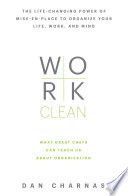

In 'Work Clean', the author emphasizes the critical role of cleanliness in both personal and professional settings. Cleanliness is not merely about physical tidiness; it extends to mental clarity and organization. The book illustrates how a clean workspace can lead to enhanced productivity, creativity, and focus. By maintaining a clean environment, individuals can minimize distractions and create a space that fosters efficiency. The author draws parallels to the culinary world, where chefs maintain immaculate kitchens to perform at their best. This analogy serves to highlight how cleanliness can be a foundational element in achieving success across various fields.
Continue readingThe author introduces the concept of rituals as a powerful tool for establishing order and consistency in work. Rituals are defined as habitual practices that create a sense of structure and predictability. In a chaotic work environment, rituals can serve as anchors that help individuals stay focused and organized. The book provides examples from different industries, showcasing how professionals implement rituals to streamline their processes. By adopting specific rituals, whether it's a morning routine or a systematic approach to task management, individuals can cultivate discipline and improve their overall work performance.
Continue readingMindfulness is a central theme in 'Work Clean', highlighting the importance of being present and aware in the moment. The author argues that mindfulness can significantly enhance productivity and decision-making. By practicing mindfulness, individuals can reduce stress and improve their ability to concentrate on tasks at hand. The book offers practical exercises and techniques to cultivate mindfulness in the workplace, such as focused breathing and intentional breaks. These practices can help individuals manage their time and energy more effectively, leading to a more balanced and fulfilling work life.
Continue readingThe author posits that creating systems is more effective than merely setting goals. While goals provide direction, systems are the processes that enable achievement. The book emphasizes the importance of establishing efficient systems that align with personal and professional aspirations. By focusing on the systems that drive daily actions, individuals can create sustainable habits that lead to long-term success. The author provides actionable steps for developing systems, encouraging readers to evaluate their current practices and make necessary adjustments to optimize their workflows.
Continue readingThe book delves into how one's environment significantly influences productivity. A well-organized and aesthetically pleasing workspace can boost motivation and creativity. The author discusses the psychological impact of clutter and disorganization, which can lead to increased stress and decreased efficiency. By curating an environment that reflects personal values and inspires creativity, individuals can enhance their productivity levels. The book also touches on the importance of ergonomics and comfort in the workspace, advocating for a holistic approach to creating an optimal work environment.
Continue readingCollaboration is a vital aspect of modern work life, and 'Work Clean' addresses the dynamics of teamwork. The author emphasizes the significance of clear communication and shared rituals in fostering a collaborative environment. By establishing common practices and expectations, teams can enhance their cohesion and efficiency. The book provides insights into how successful teams operate, highlighting the importance of mutual respect and accountability. Readers are encouraged to reflect on their own team dynamics and consider how they can contribute to a more productive and harmonious workplace.
Continue readingThe concept of continuous improvement is a recurring theme in 'Work Clean'. The author advocates for a mindset of growth and learning, encouraging individuals to regularly assess their practices and seek ways to enhance their performance. This involves being open to feedback and willing to adapt to new challenges. The book outlines strategies for implementing continuous improvement, such as setting aside time for reflection and seeking out professional development opportunities. By embracing a culture of continuous improvement, individuals can stay relevant in their fields and achieve greater levels of success.
Continue reading